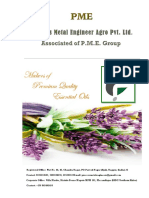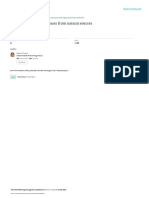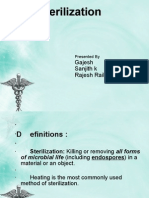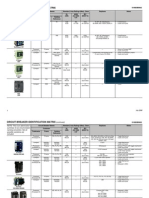PDF
Uploaded by
py4wcqvnbnCopyright:
Available Formats
PDF
Uploaded by
py4wcqvnbnOriginal Title
Copyright
Available Formats
Share this document
Did you find this document useful?
Is this content inappropriate?
Copyright:
Available Formats
PDF
Uploaded by
py4wcqvnbnCopyright:
Available Formats
PERFUME PRODUCTION
Mohammed Muthanna Mahmood Al-humadi
Üsküdar University, Faculty of Engineering and Natural Sciences,
Department of Chemical Engineering (English), 34662, Üsküdar,
Istanbul, Turkey
mohammedmm191719@gmail.com
Introduction Hypothesis
Perfume is much more than just spritzing on a pleasant fragrance. The creation 1- Integration of techniques: combining several extraction techniques to
of perfumes is an intriguing process that blends science and creativity. Getting improve selectivity and efficiency.
the aromatic elements is the first step. These might be synthetic, made in 2- Bio-based solvents: discovering biodegradable and sustainable substitutes for
laboratories, or natural, like essential oils from flowers and plants. Then, using the conventional organic extraction solvents.
a variety of techniques including solvent extraction or steam distillation, these 3- Reduced energy consumption: maximising extraction methods to reduce
aromatic components are painstakingly removed. energy use.
Purpose of the thesis Traditional perfume extraction methods
1- Enhancement and personal expression Steam distillation
2- Deliver the Fragrance Effectively: obtaining essential oils from plants, including flowers, leaves, and other
A. Concentration: Perfumes are formulated to have a specific concentration of materials. The delicate scent molecules of the plant material are preserved by
fragrance oils, ensuring a long-lasting and noticeable scent experience. the relatively mild process of steam distillation.
B. Delivery Systems: Chemical engineers play a crucial role in developing
methods to deliver the fragrance over time. This might involve encapsulation Advantages: Disadvantages:
technologies or materials that slowly release the fragrance molecules. 1- Gentle process 1- Heat exposure
C. Stability: Ensuring the fragrance remains pleasant and doesn't degrade 2- Wide applicability 2- Not ideal for all
significantly during storage or upon contact with skin is another essential 3- High yield materials
aspect of perfume production.
Types of perfume by concentration
Enfleurage
classic French technique that works especially well with delicate flowers whose
scent is easily ruined by heat.
Advantages:
Disadvantages:
1- High-quality results
1- Labour intensive
2- Suitable for heat
2- Time-consuming
sensitive materials
3- Low yield
3- Natural process
Solvent Extraction
It extracts essential oils from plant material using a liquid that has the ability to
Types of perfume by fragrance
dissolve the desired aroma molecules.
Disadvantages:
Advantages:
1- Environmental
1- Efficiency
impact
2- Versatility
2- Risk of scent
3- High yield
alteration
Emerging sustainable extraction technology
Supercritical Fluid Extraction (SFE)
This process uses a material such as carbon dioxide, a solvent when it is at a
pressure and temperature above its critical point.
Advantages: Disadvantages:
1- Selectivity 1- Very expensive
Ingredients of perfume
2- Solvent recycling 2- High power
1- Fragrance Notes 3- High-quality consumption
2- Alcohol: it guarantees that the aroma notes develop correctly and permits extracts 3- High pressure
the perfume to be applied evenly.
3- Fixatives: to extend the perfume by slowing down the fragrance components'
Conclusion
evaporation, such as: resins and musk [1].
1- The role that chemical engineering plays in all phases of the creation of
scent, particularly in terms of streamlining extraction procedures.
2- The various ways chemical engineers might improve fragrance production.
For example, by making it more environmentally friendly, economically
viable, and durable.
3- The future of the perfume industry could be shaped by the possibilities of
smart delivery systems and the impact of aroma on mood.
Reference
[1] https://www.smallflower.com/blogs/news/niche-fragrance-beginners-guide
You might also like
- MSDS CharcoalDocument11 pagesMSDS CharcoalBenny Samsul B.No ratings yet
- JSA FOR Painting Works On Storage TanksDocument6 pagesJSA FOR Painting Works On Storage TanksHaseeb Nouman Abbasi100% (2)
- Development of Latent Fingerprint by Turmeric PowderDocument8 pagesDevelopment of Latent Fingerprint by Turmeric Powdermrinaal vidaniNo ratings yet
- Reviewer in Physie MidtermsDocument5 pagesReviewer in Physie MidtermsClash of Clans22No ratings yet
- Extraction of Essential Oils Anise Carum and CardamomDocument8 pagesExtraction of Essential Oils Anise Carum and Cardamomvinaykumarkulkarni420No ratings yet
- Fragrances and Essential OilsDocument32 pagesFragrances and Essential OilsGian BanaresNo ratings yet
- DeleplanqueDocument12 pagesDeleplanqueTarek DardouriNo ratings yet
- FinalDocument23 pagesFinal514 Jeet DhiravaniNo ratings yet
- Purple AgrabattiDocument2 pagesPurple AgrabattiHarsh Ranjan SinhaNo ratings yet
- Project PresentationDocument36 pagesProject PresentationHarsh Ranjan SinhaNo ratings yet
- Unit 3 Chamda WibhagDocument3 pagesUnit 3 Chamda Wibhagmohdayan67q5No ratings yet
- Trupti Thombare IWDDocument14 pagesTrupti Thombare IWDCastleKGNo ratings yet
- PME Essential Oil BrochureDocument7 pagesPME Essential Oil BrochureAnugrah ShuklaNo ratings yet
- Mosquito Repellent by Orange PeelsDocument5 pagesMosquito Repellent by Orange PeelsBruh100% (1)
- Ijertv10n1spl 55Document4 pagesIjertv10n1spl 55JASMIN TNo ratings yet
- MSDS UreaDocument4 pagesMSDS UreaSharjeel AhmedNo ratings yet
- 7.formulation & Evaluation of Cosmetic PDTSDocument49 pages7.formulation & Evaluation of Cosmetic PDTSRaggul HaribaskarNo ratings yet
- Active-Ingredients - Cot3Document11 pagesActive-Ingredients - Cot3Benley BasiliscoNo ratings yet
- Fragmatic: Smell Only Good Phase-3Document9 pagesFragmatic: Smell Only Good Phase-3Udit AgarwalNo ratings yet
- Vasanth Resume Perfumer MPDocument5 pagesVasanth Resume Perfumer MPVasanthakumar VenkatesanNo ratings yet
- Skin Care Products - G2Document24 pagesSkin Care Products - G2CLARISSA GRACE GERALDINONo ratings yet
- Sensory Project ECauncaDocument3 pagesSensory Project ECauncaReginald GironNo ratings yet
- Products SCIENCEDocument10 pagesProducts SCIENCELouie Jane EleccionNo ratings yet
- (22PER218) Seminar and Critical ReviewDocument26 pages(22PER218) Seminar and Critical ReviewHritik SonawaneNo ratings yet
- Deux Mille Uas PosterDocument1 pageDeux Mille Uas PosterSoleil LuneNo ratings yet
- Design Developmentand Evaluationof Herbal Lipstickfrom Natural Color PigmentDocument15 pagesDesign Developmentand Evaluationof Herbal Lipstickfrom Natural Color Pigmentrozi.oropeza.swuNo ratings yet
- SterilizationDocument6 pagesSterilizationعبدالرحمن عابدNo ratings yet
- Presentation On Industrial TrainingDocument19 pagesPresentation On Industrial TrainingPratham PatelNo ratings yet
- Sop - Residual SprayingDocument2 pagesSop - Residual SprayingQS KCJNo ratings yet
- Hilirisasi Dan Produk AntaraDocument59 pagesHilirisasi Dan Produk AntaraBambang NurhadiNo ratings yet
- Essential Oils and Fragrances From Natural SourcesDocument13 pagesEssential Oils and Fragrances From Natural SourcesMaulidaNo ratings yet
- Archroma - Appretan Brochure 22 Harness The Power of Nature LOWDocument7 pagesArchroma - Appretan Brochure 22 Harness The Power of Nature LOWrajatNo ratings yet
- Sensient Beauty APAC Webinar The Art of Skincare 2023Document67 pagesSensient Beauty APAC Webinar The Art of Skincare 2023Balm Oil100% (1)
- Formulation and Evaluation of Herbal ShampooDocument12 pagesFormulation and Evaluation of Herbal ShampooTIMIR BARAN KAMLEYNo ratings yet
- Dior BronzeDocument3 pagesDior BronzeIris PredaNo ratings yet
- Coshh Assessment 2 15 March 2018 New Recent EventDocument4 pagesCoshh Assessment 2 15 March 2018 New Recent EventMohamed AtefNo ratings yet
- LPG Centrifugal Spray DryerDocument5 pagesLPG Centrifugal Spray Dryeraruna prasadNo ratings yet
- Extraction of Oil From Orange Peel by Steam DistilationDocument6 pagesExtraction of Oil From Orange Peel by Steam DistilationsrushtiannasahebbakalNo ratings yet
- 4 A Lesson PlanDocument3 pages4 A Lesson Plannancy seseNo ratings yet
- Cosmetic Chemistry Cosmetics ClassificationDocument12 pagesCosmetic Chemistry Cosmetics ClassificationScribdTranslationsNo ratings yet
- FRANGRANCE FINISH (Assignment 2)Document11 pagesFRANGRANCE FINISH (Assignment 2)Ananya KarnNo ratings yet
- Sterlization TechniqueDocument32 pagesSterlization TechniquenehadewasiNo ratings yet
- Oral CosmeticsDocument15 pagesOral CosmeticsYahia HálàwanøNo ratings yet
- FA19-CHE-083 (A) - CPI - Assignment 1Document9 pagesFA19-CHE-083 (A) - CPI - Assignment 1Maryam FatimaNo ratings yet
- Preparation and Evaluation of Herbal Cold Cream With Incorporated Curcuma LongaDocument3 pagesPreparation and Evaluation of Herbal Cold Cream With Incorporated Curcuma LongaInternational Journal of Innovative Science and Research TechnologyNo ratings yet
- 2011-12 B.tech. Cosmetic IIIDocument19 pages2011-12 B.tech. Cosmetic IIINilesh B ChaudhariNo ratings yet
- Marketing CADocument13 pagesMarketing CATanish Kar 1168No ratings yet
- Project Proposal PalaganasDocument1 pageProject Proposal PalaganasElah PalaganasNo ratings yet
- Technology of DeniumDocument17 pagesTechnology of DeniumSenthil Kumar100% (2)
- The Complexion Enhancer and Detoxifier: Biodtox™Document2 pagesThe Complexion Enhancer and Detoxifier: Biodtox™Carlos CastilloNo ratings yet
- Cotton_Dying_with_Natural_DyeDocument6 pagesCotton_Dying_with_Natural_DyeVân anh NguyễnNo ratings yet
- Extraction of Oil From Orange Peel by Steam DistillationDocument6 pagesExtraction of Oil From Orange Peel by Steam DistillationsrushtiannasahebbakalNo ratings yet
- dược HNDocument9 pagesdược HNtvthai.sdh221No ratings yet
- Introduction To Homoeopathic Drug PreparationDocument10 pagesIntroduction To Homoeopathic Drug Preparationathar husainNo ratings yet
- Master Cleanser 20241217Document4 pagesMaster Cleanser 20241217manueljosephcalmaNo ratings yet
- Paper 10346Document3 pagesPaper 10346Fatma YoussefNo ratings yet
- Sustainable Fashion - Edition 2Document11 pagesSustainable Fashion - Edition 2Willy CaoNo ratings yet
- 6 Natural Dye ND CottonDocument6 pages6 Natural Dye ND Cottonnamratakushwah2016No ratings yet
- Nancy Lesson PlanDocument2 pagesNancy Lesson Plannancy seseNo ratings yet
- Math Model of DFIG PDFDocument10 pagesMath Model of DFIG PDFFiaz AhmadNo ratings yet
- Minicargador 246D A 299D2 Plano Electrico 2017 SISDocument6 pagesMinicargador 246D A 299D2 Plano Electrico 2017 SISFabrizio Jesus Morales SalirrosasNo ratings yet
- PS SIR Inorganic QUESTION 100Document10 pagesPS SIR Inorganic QUESTION 100Arya GuptaNo ratings yet
- Coils For Fired Heaters and Boilers: ScopeDocument12 pagesCoils For Fired Heaters and Boilers: ScopeAna Bella RosarioNo ratings yet
- RB425 4 InchDocument2 pagesRB425 4 Inchmustafa.e.ahmed2017100% (1)
- Physics 1Document81 pagesPhysics 1sharad_mumNo ratings yet
- 8cyl 8coil Ext PDFDocument1 page8cyl 8coil Ext PDFwallyNo ratings yet
- NEMA ICS 10-2015, Part 4 WATERMARKEDDocument9 pagesNEMA ICS 10-2015, Part 4 WATERMARKEDJesus SalazarNo ratings yet
- Prisma G - v2016 PDFDocument204 pagesPrisma G - v2016 PDFLaura DiazNo ratings yet
- pp035-040 ms16Document6 pagespp035-040 ms16anon_320630694No ratings yet
- Data Sheet Level Gauge: GeneralDocument5 pagesData Sheet Level Gauge: GeneralJKKNo ratings yet
- Technology Development, Design and Safety Features of PHWR and Their Operating PerformanceDocument57 pagesTechnology Development, Design and Safety Features of PHWR and Their Operating PerformanceLuptonga100% (3)
- SPG en ProductCatalogue Valves Tubing 2021Document75 pagesSPG en ProductCatalogue Valves Tubing 2021jonasNo ratings yet
- ME-SFI Injection & Ignition SystemDocument42 pagesME-SFI Injection & Ignition Systemkalim shaikhNo ratings yet
- John of God Healing SessionsDocument3 pagesJohn of God Healing Sessionssusan8786No ratings yet
- Carlyle Semi HermeticsDocument38 pagesCarlyle Semi Hermeticscolive.pt100% (1)
- Circuit Breaker Identification MatrixDocument6 pagesCircuit Breaker Identification Matrixdabs_orangejuiceNo ratings yet
- Variable Pumps For Closed Loop Operation Type Hv-02Document36 pagesVariable Pumps For Closed Loop Operation Type Hv-02Eric CNo ratings yet
- Elec 2Document58 pagesElec 2Imran JamadarNo ratings yet
- Geology Powerpoint Earth LayersDocument22 pagesGeology Powerpoint Earth LayersCedric SiazonNo ratings yet
- 44355351190Document3 pages44355351190harbh9355No ratings yet
- TourismDocument19 pagesTourismdeepNo ratings yet
- CRE I- ASSIGNMENTDocument8 pagesCRE I- ASSIGNMENTmanishpraveen26No ratings yet
- Fire Protection System: Testing & Commissioning Method StatementDocument14 pagesFire Protection System: Testing & Commissioning Method Statementselcuk peken50% (2)
- Fire Load Calculation PDFDocument14 pagesFire Load Calculation PDFkermech21607No ratings yet
- Awh Datasheet Sampling Valve Rev02Document4 pagesAwh Datasheet Sampling Valve Rev02Anonymous TwpO2AUNo ratings yet
- Tempering Units G3600: Guardian EquipmentDocument2 pagesTempering Units G3600: Guardian Equipmenteisenbarger5607No ratings yet





















































































